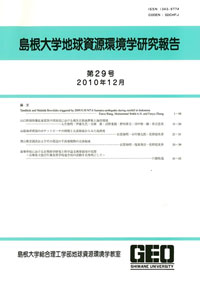島根大学総合理工学部地球資源環境学教室
ISSN:1343-9774

number of downloads : ?
Use this link to cite this item : https://ir.lib.shimane-u.ac.jp/31601
Geoscience reports of Shimane University 33
2015-02-27 発行
Two modes of occurrence of garnets from the Tonaru metagabbro mass in the Sambagawa metamorphic belt, central Shikoku, Japan
File
Description
Garnet epidote amphibolite from the central part of the Tonaru metagabbro mass consists mainly of garnet, epidote and amphibole (ferro-hornblende), with small amounts of quartz, plagioclase (albite and oligoclase) and paragonite. Rutile, apatite, hematite, calcite and chlorite occur occasionally. Garnets in the garnet epidote amphibolites exhibit two modes of occurrence. Garnet 1 (Grt 1) occurs as porphyroblast, and garnet 2 (Grt 2) is found as fine grain in the matrix. Porphyroblastic garnets show a prograde growth zoning with increasing X_<Pro> and decreasing X_<Sps> from core to rim. Some of them display thin (< 0.2 mm) outermost rim, which can be identify only from backscattered electron image. The outermost rim also shows a prograde growth zoning with outward decrease and increase in X_<Pro> and antithetic zoning in X_<Sps>. This outermost rim of porphyroblastic garnet (Grt 1) is similar to that of fine grained garnet (Grt 2). Diversity of the mode of occurrence and the chemical compositions of the garnets, the metamorphic evolution of the garnet epidote amphibolite is divided into two metamorphic events. These are a first high-pressure metamorphic event of eclogite facies (i) represented by porphyroblastic the garnet. And a second high-pressure which are metamorphic event (ii) is recorded by the outermost rim of porphyroblastic garnet and fine-grained garnet in the matrix, similar the prograde Sambagawa metamorphism of the oligoclase-biotite zone.
Other Article
PP. 19 - 27
